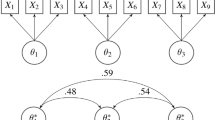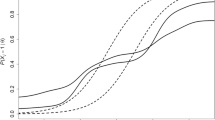Abstract
Compared to the measurement of other latent traits like attitudes or abilities, measurement of quality of life poses somewhat more and somewhat different methodological challenges. This paper discusses issues like unidimensionality, number of answer categories per item, information source and the choice between general and group specific questionnaires. It is argued that item response theory can make a useful contribution to quality of life measurement. The parametric Rasch model and the nonparametric Mokken model are viewed as particularly promising.
Access this chapter
Tax calculation will be finalised at checkout
Purchases are for personal use only
Preview
Unable to display preview. Download preview PDF.
Similar content being viewed by others
References
Andersen, E.B. (1980). Comparing latent distributions. Psychometrika 45, 121–134.
Andersen, E.B. and W0lk Olsen, L.(2001). The life of Georg Rasch as a mathematician and as a statistician. In: A. Boomsma, M.A.J. van Duijn, and T.A.B. Snijders (eds.), Essays on Item Response Theory. New York: Springer-Verlag.
De Leeuw, E.D and Collins, M. (1997). Data collection methods and survey quality: an overview. In: Lyberg, L., Biemer, P., Collins, M., de Leeuw, E., Dippo, C., Schwartz, N. and Trewin, D. (eds.), Survey Measurement and Process Quality. New York: Wiley.
De Leeuw, E.D., Hox, J.J. and Snijers, G. (1995). The effect of computer assisted interviewing on data quality: a review. Journal of Market Research Society 37, 325–344.
Diaz, P., Mercier, C., Hachey, R., Caron, J. and Boyer, G. (1999). An evaluation of psychometric properties of the client’s questionnaire of the Wisconsin Quality of Life Index-Canadian Version (CaW-QLI). Quality of Life Research 8, 509–514.
Ellis, J.L. and Van den Wollenberg, A.L. (1993). Local homogeneity in latent trait models. A characterization of the homogeneous monotone IRT model. Psychometrika 58, 417–429.
Fayers, P.M., Hand, D.J., Bjordal, K. and Groenvold, M. (1997). Causal indicators in quality of life research. Quality of Life Research 6, 393–406.
Fischer, G.H. and Molenaar, I.W., eds. (1995). Rasch Models: Foundations, Recent Developments, and Applications. New York: Springer-Verlag.
Fischer, G.H. (1995). Derivations of the Rasch model. In: Fischer, G.H. and Molenaar, I.W. (eds.), Rasch Models: Foundations, Recent Developments, and Applications. New York: Springer-Verlag.
Glas, C.A.W. and Verhelst, N.D. (1995). Testing the Rasch model. In: Fischer, G.H. and Molenaar, I.W. (eds.), Rasch Models: Foundations, Recent Developments, and Applications. New York: Springer-Verlag.
Grayson, D.A. (1988). Two-group classification in latent trait theory: scores with monotone likelihood ratio. Psychometrika 53, 383–392.
Hawthorne, G., Richardson, J. and Osborne, R. (1999). The Assessment of Quality of Life (AQoL) instrument: a psychometric measure of health-related quality of life. Quality of Life Research, 8, 209–224.
Hemker, B.T., Sijtsma K., Molenaar, I.W. and Junker, B.W. (1996). Polytomous IRT models and monotone likelihood ratio of the total score. Psychometrika 61, 679–693.
Hemker, B.T., Sijtsma K., Molenaar, I.W. and Junker, B.W. (1997). Stochastic ordering using the latent trait and the sum score in polytomous IRT models. Psychometrika 62, 331–347.
Junker, B.W. (2001). On the interplay between nonparametric and parametric IRT, with some thoughts about the future. In: Boomsma, A., van Duijn, M.A.J. and Snijders, T.A.B. (eds.), Essays on Item Response Theory. New York: Springer-Verlag.
Lindsay, B.G., Clogg, C.C. and Grego, J. (1991). Semiparametric estimation in the Rasch model and related exponential response models, including a simple latent class model for item analysis. Journal of the American Statistical Association 86, 96–107.
Loevinger, J. (1948). The technique of homogeneous tests compared with some aspects of “scale analysis” and factor analysis. Psychological Bulletin 45, 507–530.
Lord, F.M. and Novick, M.R. (1968). Statistical Theories of Mental Test Scores. Reading MA: Addison-Wesley.
Mokken, R.J. (1971). A Theory and Procedure of Scale Analysis: With Applications in Political Research. The Hague: Mouton, Berlin: De Gruyter.
Molenaar, I.W. (1992). Statistical Models for Educational Testing and Attitude Measurement. In: van der Heijden, P.G.M., Jansen, W. Francis, B. And Seeber, G.U.H. (eds.), Statistical Modeling. Amsterdam: Elsevier Science Publishers.
Molenaar, I.W. (1995). Some background for item response theory and the Rasch model. In: Fischer, G.H. and Molenaar, I.W. (eds.), Rasch Models: Foundations, Recent Developments, and Applications. New York: Springer-Verlag.
Molenaar, I.W. and Sijtsma, K. (2000). User’s manual MSP5 for Windows: A Program for Mokken Scale Analysis for Polytomous Items. Version 5.0 [Software manual]. Groningen: ProGAMMA.
Neyman, J. and Scott, E.L. (1948). Consistent estimates based on partially consistent observations. Econometrica 16, 1–32.
Ramsay, J.O. (1991). Kernel smoothing approaches to nonparametric item characteristic curve estimation. Psychometrika 56, 611–630.
Rasch, G. (1960). Probabilistic Models for Some Intelligence and Attainment Tests. Copenhagen: The Danish Institute of Educational Research. [Expanded edition, 1980, Chicago: The University of Chicago Press].
Richman, W.L., Kiesler, S. Weisband, S. and Drasgow, F. (1999). A meta-analytic study of social desirability distortion in computer administered questionnaires, traditional questionnaires and interviews. Journal of Applied Psychology 84, 754–775.
Ringdal, K., Ringdal, G.I., Kaasa, S., Bjordal, K., Wisløff, F., Sundstrøm, S. and Hjermstad, M.J. (1999). Assessing the consistency of psychometric properties of the HRQoL scales within the EORTC QLQ-C30 across populations by means of the Mokken scaling model. Quality of Life Research 8, 25–43.
Sijtsma, K. (1998). Methodology review: nonparametric IRT approaches to the analysis of dichotomous item scores. Applied Psychological Measurement 22, 3–32.
Sijtsma, K., and Van der Ark, L.A. (2001). Progress in NIRT analysis of polytomous item scores: dilemmas and practical solutions. In Boomsma, A., van Duijn, M.A.J. and Snijders, T.A.B. (eds.), Essays on Item Response Theory (pp. 297–318). New York: Springer-Verlag.
Stout, W.F. (1990). A new item response theory modeling approach with applications to unidimensionality assessment and ability estimation. Psychometrika 55, 293–325.
Theunissen, N.C.M., Vogels, T.G.C., Koopman, H.M., Verrips, G.H.W., Zwinderman, K.A.H., Verloove-Vanhorick, S.P. and Wit, J.M. (1998). The proxy problem: child report versus parent report in health-related quality of life research. Quality of Life Research 7, 387–397.
Tsutakawa, R.K. and Johnson, J.C. (1990). The effect of uncertainty of item parameter estimation on ability estimates. Psychometrika 55, 371–390.
Van der Linden, W.J. and Hambleton, R.K., eds. (1997). Handbook of Modern Item Response Theory. New York: Springer Verlag.
Verhelst, N.D. and Glas, C.A.W. (1995). The one parameter logistic model. In: Fischer, G.H. and Molenaar, I.W. (eds.), Rasch Models: Foundations, Recent Developments, and Applications. New York: Springer-Verlag.
Wainer, H. (1990). Computerized Adaptive Testing. A Primer. Hillsdale NJ: Erlbaum.
Warm, T.A. (1989). Weighted likelihood estimation of ability in item response models. Psychometrika 54, 427–450.
Zhang, J. and Stout, W.F. (1999a). Conditional covariance structure of generalized compensatory multidimensional items. Psychometrika 64, 129–152.
Zhang, J., and Stout, W.F. (1999b). The theoretical DETECT index of dimensionality and its application to approximate simple structure. Psychometrika 64, 213–249.
Author information
Authors and Affiliations
Editor information
Editors and Affiliations
Rights and permissions
Copyright information
© 2002 Springer Science+Business Media Dordrecht
About this chapter
Cite this chapter
Molenaar, I.W. (2002). Parametric and Nonparametric Item Response Theory Models in Health Related Quality of Life Measurement. In: Mesbah, M., Cole, B.F., Lee, ML.T. (eds) Statistical Methods for Quality of Life Studies. Springer, Boston, MA. https://doi.org/10.1007/978-1-4757-3625-0_12
Download citation
DOI: https://doi.org/10.1007/978-1-4757-3625-0_12
Publisher Name: Springer, Boston, MA
Print ISBN: 978-1-4419-5207-3
Online ISBN: 978-1-4757-3625-0
eBook Packages: Springer Book Archive




